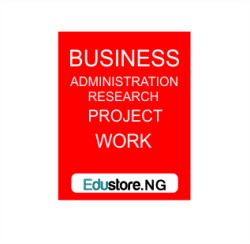CHAPTER ONE
1.1 Background To The Study
E-procurement involves the use of internet ,information networking systems, such as electronic for the purchase and sales of supplies, work and services between the government and other firms. E-procurement value chain consists e-Tendering, e-Auctioning, of indent management, e-Informing, vendor management, catalogue management, Purchase Order Integration, Order Status, Ship Notice, e-invoicing, e-payment and contract management.
.Baily (2008) classifies e-procurement into the seven categories: the first is Web-based ERP (Enterprise Resource Planning)., E-MRO (Maintenance, Repair and Operations), E-sourcing, E-tendering ,E-reverse auctioning , E-informing ,and E-market site. According to Eadie et al (2007),the benefit of E-procurement include, Price reduction in tendering, efficient for the finding and connecting of new sources, Lower Administration costs, Reduction in procurement staff and competitive advantage over competitors. A centralized department in the firm can oversee the coordination of all procurement activities for different branches and different offices worldwide can access the same documentation when required, this gives a distinct advantage over the much slower process of having to post documentation between offices. This extends the supply chain beyond geographical boundaries to a much wider group. It facilitates timely delivery and quality delivery of products and services, greater market access but also increased productivity. The research seeks to investigate the effects of e-procurement in the public sector.
1.2 Statement of the Problem
The evolution of e-procurement is also faced with some challenges. Uncertainty lies regarding the legal position of e-procurement. The fear is that whether firms can recognize electronically sent documents as valid or legal. E-procurement is also faced with the problem of Lack of IT infrastructure, Wong and Sloan (2004) stated that most firms lacked the relevant technology to carry out e-procurement. Also Harrigan (2008) identified other challenges to include system-to-system integration, ICT/technical issues, technological integration , data quality, and cost of implications of the system. Baily (2008) classifies e-procurement into the seven categories: the first is Web-based ERP (Enterprise Resource Planning)., E-MRO (Maintenance, Repair and Operations), E-sourcing, E-tendering ,E-reverse auctioning , E-informing ,and E-market site. According to Eadie et al (2007),the benefit of E-procurement include, Price reduction in tendering, efficient for the finding and connecting of new sources, Lower Administration costs, Reduction in procurement staff and competitive advantage over competitors. A centralized department in the firm can oversee the coordination of all procurement activities for different branches and different offices worldwide can access the same documentation when required, this gives a distinct advantage over the much slower process of having to post documentation between offices. This extends the supply chain beyond geographical boundaries to a much wider group. It facilitates timely delivery and quality delivery of products and services, greater market access but also increased productivity. The problem confronting the research is to determine the effects of e-procurement in the public sector.
1.3 Objectives of the Study
To determine the effects of e-procurement in the public sector
1.4 Research Question
What is E-procurement?
What is the effect of e-procurement in the public sector?
1.5 Significance of the Study
The study shall proffer an appraisal of the effects of e-procurement in the public sector
E-procurement involves the use of internet ,information networking systems, such as electronic for the purchase and sale of supplies, work and services between the government and other firms. E-procurement value chain consists e-Tendering, e-Auctioning, of indent management, e-Informing, vendor management, catalogue management, Purchase Order Integration, Order Status, Ship Notice, e-invoicing, e-payment and contract management.
.Baily (2008) classifies e-procurement into the seven categories: the first is Web-based ERP (Enterprise Resource Planning)., E-MRO (Maintenance, Repair and Operations), E-sourcing, E-tendering ,E-reverse auctioning , E-informing ,and E-market site. According to Eadie et al (2007),the benefit of E-procurement include, Price reduction in tendering, efficient for the finding and connecting of new sources, Lower Administration costs, Reduction in procurement staff and competitive advantage over competitors. A centralized department in the firm can oversee the coordination of all procurement activities for different branches and different offices worldwide can access the same documentation when required,
1.6 Research Hypothesis
Ho The effects of e-procurement in the public sector is low
Hi The effects of e-procurement in the public sector is high
1.7 Scope of the Study
The study focuses on the appraisal of the effects of e-procurement in the public sector
1.8 Limitations of the Study
The study was confronted by some constraints including logistics and geographical factor.
REFERENCES
American International Journal of Contemporary Research (2013) Vol. 3 No. 8; August 105
Baily, P. J. H. (2008). Procurement principles and management. Harlow, England: Prentice Hall Financial Times. p. 394.
. Mettler T, Rohner P (2009). “E-Procurement in Hospital Pharmacies: An Exploratory Multi-Case Study from Switzerland”. IJournal of Theoretical and Applied Electronic Commerce Research.
U.S. Department of Health and Human Services, Health Resources and Services Administration. Retrieved 27 June 2013.
DOWNLOAD COMPLETE WORK- For Reference Only: Materials are for research, citation, and idea generation purposes and not for submission as your original final year project work.
- Avoid Plagiarism: Do not copy or submit this content as your own project. Doing so may result in academic consequences.
- Use as a Framework: This complete project research material should guide the development of your own final year project work.
- Academic Access: This platform is designed to reduce the stress of visiting school libraries by providing easy access to research materials.
- Institutional Support: Tertiary institutions encourage the review of previous academic works such as journals and theses.
- Open Education: The site is maintained through paid subscriptions to continue offering open access educational resources.





